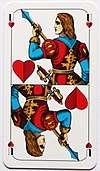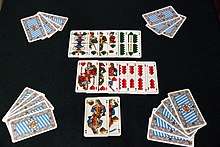Unteransetzen
Unteransetzen, Unteranlegen or Unterauflegen is an Austrian card game of the Domino family for 2-6 players that is played exclusively with German playing cards. The name means refers to the building of cards onto an Unter (the equivalent of the Jack in a French pack). It is a classic children's game.[1]
 The Unter of Hearts, the usual starting card | |
| Origin | Austria |
|---|---|
| Alternative names | Unteranlegen, Unterauflegen |
| Type | Shedding game |
| Players | 2–6 |
| Age range | 6+ |
| Cards | 32 |
| Deck | William Tell pattern |
| Play | Clockwise |
| Card rank (highest first) | A K O U 10 9 8 7 |
| Related games | |
| Domino, Sevens, Zehnerlegen | |
Overview
Although Domino-style games are common in Europe, the game known as Unteransetzen is only recorded in Austria where it is very popular in Salzburg and Upper Austria, but also played in every other state bar Tyrol. It has many variants: those in which the Unter of Hearts is the starting card (Rot-Mandl-Auflegen or Rot-Unter-Ansetzen), those in which the Unter of Leaves is the leading card (Grünmandlansetzen or Grünunteransetzen) and those in which any Unter may start (Unter-Anlegen, Unter-Ansetzen, Unter-Auflegen or Unterlegen).[1]
Unteransetzen is also a component of compendium games such as Rosbiratschka[2] Kein Stich or Herzeln.[3]
Cards
The game is usually played with a William Tell pack. In a 2-player game, a third of the pack is placed, face down, as a talon from which to draw. Otherwise all cards are dealt. Cards rank in their natural order – Sow, King, Ober, Unter, Ten, Nine, Eight, Seven – and there are no trumps.[1]
Playing

Usually the player with the Unter of Hearts leads; sometimes the Unter of Leaves is used (hence names like Grünunteransetzen). In clockwise order, players then attempt to 'build' onto the first card by laying next to it the next higher or lower card in suit sequence i.e. the second player would play either the Ober of Hearts or the Ten of Hearts. If a player cannot build in the same suit, they may lay another Unter, above or below the first, in suit order i.e. the ![]()
![]()
![]()
![]()
The player who is first to shed all their cards is the winner.[5]
References
- Geiser (2004), p. 48.
- Spielregelbüchlein (1988), pp. 175/176
- Herzeln at www.spieletest.at. Retrieved 4 Nov 2018
- Hülsemann 1930, pp. 285/286.
- Bamberger & Bruhns 1999, p. 71.
Literature
- Altenburger Spielfabrik, Erweitetes Spielregelbüchlein aus Altenburg, 8th edition, Dresden (1988)
- Bamberger, Johannes and Erika Bruhns (1999). Kartenspiele für Kinder. Perlen-Reihe Vol. 644. Franz Deutiger Verlag, Vienna. ISBN 3-85223-436-0
- Geiser, Remigius (2004). "100 Kartenspiele des Landes Salzburg", in Talon, Issue 13.
- Hülsemann, Robert (1930). Das Buch der Spiele für Familie und Gesellschaft. Hesse & Becker, Leipzig.
External links
- "Unter-Anlegen" in Spiel und Spaß mit Freunden at /www.kirchenzeitung.at. Rules for Unter-Anlegen.